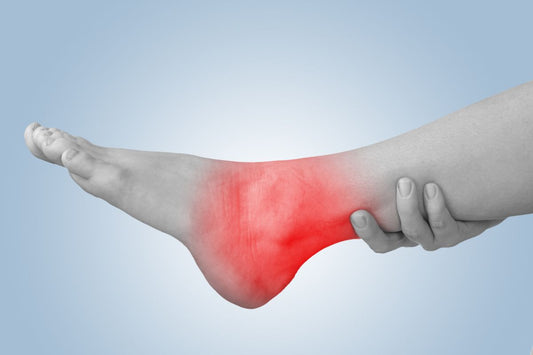It’s one thing to experience ankle pain after a clear injury — a twist, a fall, or a wrong step. But what if that sharp ache or throbbing discomfort comes out of nowhere, seemingly without cause?
If you're dealing with sudden ankle pain without injury, you’re not alone. Thousands of people each month search for answers to pain that appears without explanation, sometimes even without swelling or bruising. And while it might seem minor, unexplained ankle pain can be a sign of an underlying condition that shouldn’t be ignored.
In this article, we’ll explore why ankle pain can strike without an obvious injury, what might be causing it, and when it’s time to seek help.
Is It Possible to Have Ankle Pain Without an Injury?
Yes — and it’s more common than most people realize.
While trauma is a common cause of ankle issues, not all pain stems from sudden impacts or accidents. The ankle joint is supported by complex structures: bones, tendons, ligaments, nerves, and bursae. Dysfunction or inflammation in any of these can cause pain — even if you didn’t twist your ankle or roll it recently.
People who lead active lifestyles, spend long hours on their feet, or have underlying health conditions can develop ankle pain without any memorable injury.
Common Causes of Sudden Ankle Pain Without Injury
Let’s look at some of the most common medical reasons behind unexplained ankle pain:
1. Tendonitis
Tendonitis occurs when a tendon becomes inflamed due to overuse or strain. In the ankle, this often affects the peroneal tendons (on the outside of the foot) or the posterior tibial tendon (on the inside). Pain may be sharp or aching, and can worsen with walking or activity — even without a specific injury event.
2. Arthritis
Early arthritis, especially osteoarthritis or rheumatoid arthritis, can cause ankle pain that appears out of the blue. Inflammation inside the joint leads to stiffness and discomfort. Symptoms can be subtle at first — especially in the morning — and may worsen over time.
3. Gout
Gout is a form of inflammatory arthritis caused by excess uric acid in the blood, which crystallizes in joints — often suddenly and painfully. The ankle (especially the front or top) may feel hot, red, and incredibly tender, even without prior trauma.
4. Nerve Impingement
Compressed or irritated nerves can refer pain into the ankle. For example, tarsal tunnel syndrome (similar to carpal tunnel, but in the foot) can cause tingling, burning, or stabbing pain near the inner ankle, especially without swelling.
5. Bursitis
Bursae are small, fluid-filled sacs that cushion your joints. Ankle bursitis — inflammation of these sacs — can lead to sharp or achy pain, especially when pressure is applied (e.g., wearing tight shoes).
6. Stress Fracture or Microtrauma
Repeated strain from running, jumping, or even walking long distances can lead to small bone cracks known as stress fractures. Pain may develop gradually, but can feel sudden when symptoms flare.
7. Infection (Rare)
While not common, infections in the joint or surrounding tissue can cause ankle pain without trauma. This is often accompanied by fever, redness, or general illness and should be treated as a medical emergency.
What If There’s No Swelling?
You might wonder: If I have a sudden ankle pain without swelling, does that mean it’s not serious?
Not necessarily.
Swelling is a common response to inflammation or injury, but some conditions — such as nerve impingement, early arthritis, or mild tendon irritation — may still cause pain without visible swelling. The absence of swelling could also delay how seriously people take the discomfort, allowing the condition to worsen.
Pay attention to other symptoms like tenderness when pressing on the ankle, pain while walking, or stiffness in the morning.
When to See a Doctor
Some ankle pain resolves on its own with rest, but there are times when professional help is crucial. Seek medical advice if:
- The pain lasts more than a few days without improvement
- You cannot bear weight or walk comfortably
- The pain is intense or sharp, especially at night
- You notice numbness, tingling, or radiating pain
- There’s unexplained redness or warmth (possible sign of infection)
A podiatrist, orthopedist, or primary care physician can evaluate your symptoms, possibly using X-rays, ultrasounds, or MRIs to identify the underlying issue.
As always, it's better safe than sorry: When in doubt, consult a healthcare professional.
Treatment and Support Options
Depending on the cause, a few different strategies can help manage sudden ankle pain without injury:
R.I.C.E. Method
This stands for Rest, Ice, Compression, and Elevation — a first-line response for reducing inflammation and preventing further strain.
Ankle Braces and Compression Sleeves
Wearing an ankle brace or compression sleeve can support weakened structures and limit painful movements. These are especially useful for tendonitis, arthritis, or recovery from repetitive strain.
Pain Relief
Over-the-counter medications like ibuprofen or topical analgesics can reduce inflammation and provide temporary relief.
Physical Therapy
In cases involving overuse, improper mechanics, or weakness, guided exercises can help restore strength and mobility in the ankle.
Final Thoughts
Sudden ankle pain without injury can be frustrating — especially when there’s no clear explanation. But just because there’s no visible trauma doesn’t mean the pain isn’t real. Internal inflammation, irritated tendons, or early joint changes are all common culprits that can sneak up without warning.
Listen to your body, and don’t delay care if the pain lingers or worsens. Early intervention — whether with supportive gear, rest, or medical guidance — can make all the difference in keeping your ankle strong, stable, and pain-free.




